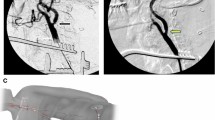Abstract
We performed bilateral femoral artery dissections in a single 50 kg mongrel dog. Digital fluoroscopic arteriograms documented the luminal diameter of the left iliac and right superficial femoral arteries. Balloon thrombectomy catheter passage was performed through hemostatic sheaths by 12 surgeons. Embolectomy balloons were filled with radiographic contrast material and the balloon catheter diameter was compared with the underlying vessel diameter. The percentage of overdistention of the embolectomy balloon relative to the arterial wall was 23%±5% in the iliac artery and 40%±13% in the femoral artery. Over a 25-month period, we used fluoroscopically assisted thromboembolectomy to treat 21 patients with acute arterial or graft occlusions. As the balloon was gently withdrawn to extract intravascular thrombus, deformities of the compliant balloon profile caused by underlying arterial lesions were identified fluoroscopically and their locations recorded to facilitate further treatment. After initial clot removal in these 21 patients, 15 residual lesions were documented. Repeat thrombectomy (n=8), balloon angioplasty (n=3), and placement of intravascular stents (n=4) eliminated all 15 lesions. Luminal continuity was successfully restored in all 21 of these patients, 10 of whom required distal open vascular reconstruction to correct existing outflow artery disease. Fluoroscopically assisted thromboembolectomy is a simple and safe method for treating acute arterial or graft occlusions in patients with diffuse arteriosclerosis. It minimizes arterial damage and blood loss during balloon thrombectomy and reduces the need for intravascular contrast agents. It also has the potential to facilitate accurate identification, localization, and treatment of significant underlying arterial lesions.
Similar content being viewed by others
References
Fogarty T, Cranley J, Krause R, et al. A method for extraction of arterial emboli and thrombi. Surg Gynecol Obstet 1963;116:241–244.
Kendrick J, Thompson B, Read R, et al. Arterial embolectomy in the leg: Results in a referral hospital. Am J Surg 1981;142:739–743.
Panetta T, Thompson J, Talkington C, et al. Arterial embolectomy: A 34-year experience with 400 cases. Surg Clin North Am 1986;66:339–353.
Abbott W, Maloney R, McCabe C, et al. Arterial embolism: A 44-year perspective. Am J Surg 1982;143:460–464.
Green R, DeWeese J, Rob C. Arterial embolectomy before and after the Fogarty catheter. Surgery 1975;77:24–33.
Haimovici H, Moss C, Veith F. Arterial embolectomy revisited. Surgery 1975;78:409–410.
Murray G. Heparin in thrombosis and blood vessel surgery. Surg Gynecol Obstet 1941;72:340–344.
Blaisdell F, Steele M, Allen R. Management of acute lower extremity arterial ischemia due to embolism and thrombosis. Surgery 1978;84:822–834.
Veith FJ, Panetta TF, Wengerter KR, et al. Femoral-poplitealtibial occlusive disease. In Veith FJ, Hobson RW II, Williams RA, eds. Vascular Surgery. Principles and Practice, 2nd ed. New York: McGraw-Hill, 1994, pp 421–446.
Foster J, Carter J, Edwards W, et al. Arterial injuries secondary to the use of the Fogarty catheter. Ann Surg 1970;171:971–978.
Chidi C, DePalma R. Atherogenic potential of the embolectomy catheter. Surgery 1987;83:549–557.
Goldberg EM, Goldberg MC, Chowdhury LN, et al. The effects of balloon embolectomy-thrombectomy catheters on vascular architecture. J Cardiovasc Surg 1983;24:74–80.
Jorgensen RA, Drobin PB. Balloon embolectomy catheters in small arteries. IV. Correlation of shear forces with histologic injury. Surgery 1983;93:798–808.
Poole JCF, Cromwell SB, Benditt EP. Behavior of smooth muscle cells and formation of extracellular structures in the reaction of arterial walls to injury. Am J Pathol 1971;62:391–404.
Dainko E. Complication of the use of the Fogarty balloon catheter. Arch Surg 1972;105:79–82.
Charlesworth PM, Brewster DC, Darling RC. Renal artery injury from a Fogarty balloon catheter. J Vasc Surg 1984;1:573–576.
Cranley JJ, Krause RJ, Strasser ES, et al. Catheter technique for arterial embolectomy: A seven year experience. J Cardiovasc Surg 1970;11:44–51.
Masuoka S, Shimomura T, Ando T, et al. Complications associated with the use of the Fogarty balloon catheter. J Cardiovasc Surg 1980;21:67–74.
Author information
Authors and Affiliations
Additional information
Supported by grants from the United States Public Health Service (HL 02990-03), the James Hilton Manning and Emma Austin Manning Foundation, the Anna S. Brown Trust, and the New York Institute for Vascular Studies.
About this article
Cite this article
Parsons, R.E., Marin, M.L., Veith, F.J. et al. Fluoroscopically assisted thromboembolectomy: An improved method for treating acute arterial occlusions. Annals of Vascular Surgery 10, 201–210 (1996). https://doi.org/10.1007/BF02001883
Issue Date:
DOI: https://doi.org/10.1007/BF02001883




